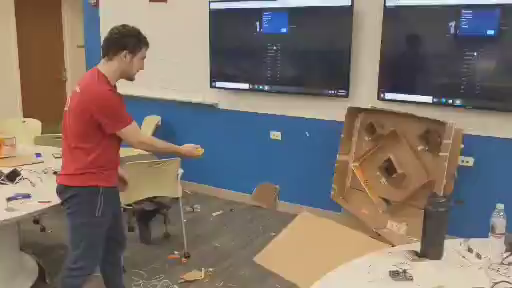Skeeball

Description as a Tweet:
This is Skeeball, a game where you roll a ball off a ramp into a hole, and try to score points!
Inspiration:
After thinking about games which we played as a kid, this game came up and we HAD to do it. It was a fun game, so why not put our own spin on it?
What it does:
Our project tries to recreate the feeling of playing the original Skeeball game, and does this using a Raspberry Pi, a series of ultrasonic distance sensors, and a NodeJS backend to store the high scores of players.
How we built it:
We have ultrasonic distance sensors which detect the distance between objects; utilizing that strategy, we can detect if an object is close to the sensor (which would be routed based on the Skeeball structure), and award the correct number of points based on that.
From there, we decided to use a Raspberry Pi to receive the signals (via GPIO) and assign scores, and a NodeJS/Postgres backend to store the scores which are received.
Then we put together a cardboard version of the game, and 3D printed Skeeballs to use.
Technologies we used:
- Javascript
- Node.js
- Express
- React
- Raspberry Pi
Challenges we ran into:
- We originally attempted to do this with an Arduino, but that required multiple Arduinos, and also wasn't very efficient.
- The distance sensors were very inaccurate until we figured out how to do a smoothing algorithm on it, and even then the smoothing algorithm inhibited performance.
- Wiring was a big problem (due to small wires), and because of that it was very difficult to test at first.
- One of our sensors blew up.
- Cardboard was hard to utilize for our project, because it kept sagging in some places.
- The ball kept getting stuck, which we had to fix by turning to Physics.
Accomplishments we're proud of:
Being able to get a minimum viable product, and have it working somewhat consistently, is something we are proud of. This wasn't exactly easy, but we had a lot of fun doing it, and we all learned something new from it.
What we've learned:
What I learned is that even though an idea may come out perfect in your head, there is always a slim chance that it won't come out perfect when you translate it to real life. Because of this, you need to improvise, adapt, overcome, and know when to use an alternative solution. It's okay that things don't go right the first time, but all that matters is that you know how to deal with it.
What's next:
Our next goal is to embellish the product with more features (LEDs for the rings, visual points indicators, etc).
Built with:
Cardboard, hot glue, duct tape, scotch tape, Raspberry Pi (with touch screen), Dupont wires, Postgres, NodeJS, 3D printer (for the balls).
Prizes we're going for:
- Best Use of AWS
- Best Hardware Hack
- Best Beginner Hardware
- Best Hardware Hack
Team Members
Ibrahima Keita
Kobi Falus
Saif Masoud
